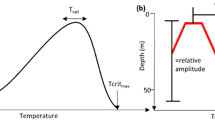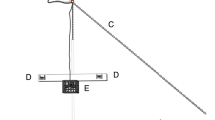Abstract
The homing behavior of scalloped hammerhead sharks (Sphyrna lewini) to and fro between Espiritu Santo Seamount and Las Animas Island and the surrounding pelagic environment was studied to reveal their mechanisms of navigation in the oceanic environment. Four sharks were tagged with ultrasonic transmitters and tracked at the former location and one shark at the latter site during July, August, or September between 1981 and 1988. Hammerhead swimming movements were highly oriented: the mean coefficient of concentration (r) for sets of ten consecutive swimming directions recorded during eight homing movements by three hammerhead sharks ranged from 0.885 to 0.996. Drift within a current could not explain this directionality, since highly variable directions were recorded from a transmitter floating at the sea surface after becoming detached from a shark. Forward swimming momentum was an unlikely explanation, since highly directional swimming was maintained for a period of 32 min with only a gradual change in course. To maintain directionality over this period, an environmental property should be necessary for guidance. The hammerheads swam at night, with repeated vertical excursions ranging from 100 to 450 m deep, out of view of either the sea surface or the sea floor. The sharks' vertical diving movements were compared to distributions of spectral irradiance (relative to elasmobranch scotopic and photopic visual sensitivities), temperature, and current-flow directions in the water column. No relationships were evident between these properties and the sharks' oriented swimming movements. Movements of scalloped hammerhead sharks to and from a seamount were compared to topographic features in bathymetry and geomagnetic field leading away from the seamount. Sharks swam repeatedly over fixed geographic paths, and these paths occurred less often along submarine ridges and valleys than maxima and minima in the geomagnetic field. No significant difference existed between the degree of association of points from the sharks' tracks and points from track simulations and ≥20° changes in the slope of the depth record. On the other hand, significantly more points from the sharks' tracks were associated with slope changes in the magnetic intensity record than points from track simulations. A magnetic intensity gradient of 0.037 nanoteslas/m (nT/m) existed at 175 m depth, where a shark swam directionally, and this gradient was three times steeper than that measured at the sea surface and exceeded that recorded at a depth of 200 m. The hammerheads are hypothesized to find the seamount using geomagnetic topotaxis. The shark could be attracted to and move back and forth along ridges and valleys, features in the relief of magnetic field intensities occurring over a geographical area.
Similar content being viewed by others
Literature cited
Bovet, P., Benhamou, S. (1988). Spatial analysis of animals' movements using a correlated random walk model. J. theor. Biol. 131: 419–433
Carey, F. G., Kanwisher, J. W., Brazier, O., gabrielson, G., Casey, J. G., Pratt, Jr., H. L. (1982). Temperature and activities of a white shark, Carcharodon carcharias. Copeia 1982: 254–260
Carey, F. G., Robison, B. H. (1981). Daily patterns in the activities of swordfish, Xiphias gladius, observed by acoustic telemetry. Fish. Bull. U.S. 79: 277–292
Carey, F. G., Scharold, J. V. (1990). Movements of blue sharks (Prionace glauca) in depth and course. Mar. Biol. 106: 329–342
Cigas, J., Klimley, A. P. (1987). A microcomputer interface for decoding telemetry data and displaying them numerically and graphically in real time. Behav. Res. Meth., Instrums, Computers 19: 19–25
Doving, K. B., Westerberg, H., Johnsen, P. B. (1985). Role of olfaction in the behavioral and neuronal responses of Atlantic salmon, Salmo salar, to hydrographic stratification. Can. J. Fish. aquat. Sciences 42: 1658–1667
Gove, P. B. (ed.) (1966). Webster's third new international dictionary of the English language. G & C Merriam Co., Spring-field, Mass.
Greer Walker, M., Harden Jones, F. R., Arnold, G. P. (1978). The movements of plaice (Pleuronectes platessa L.) tracked in the open sea. J. Cons. int. Explor. Mer. 38: 58–86
Gruber, S. H. (1967). A behavioral measurement of dark adaptation in the lemon shark, Negaprion brevirostris. In: Gilbert, P. W., Mathewson, R. F., Rall, D. P. (eds.) Sharks, skates and rays. Johns Hopkins Press, Balitmore, p. 479–490
Gruber, S. H., Cohen, J. L. (1978). Visual system of the elasmobranchs: state of the art 1960–1975. In: Hodgson, E. S., Mathewson, R. F. (eds.) Sensory biology of sharks, skates and rays. U.S. Government Printing Office, Washington, p. 11–105
Gruber, S. H., Nelson, D. R., Morrissey, J. F. (1988). Patterns of activity and space utilization of lemon sharks, Negaprion brevirostris, in a shallow Bahamian lagoon. Bull. mar. Sci. 43: 61–76
Hansen, L. P., Doving, K. B., Jonsson, B. (1987). Migration of farmed adult Atlantic salmon with and without olfactory sense, released on the Norwegian coast. J. Fish Biol. 30: 713–721
Harden Jones, F. R. (1981). Fish migration: strategy and tactics. In: Aidley, D. J. (ed.) Animal migration, Cambridge University Press, Cambridge, p. 139–165
Harden Jones, F. R., Arnold, G. P. (1982). Acoustic telemetry and the marine fisheries. In: Cheeseman, C. L., Mitson, R. B. (eds.) Telemetry studies of vertebrates. Academic Press, London, p. 75–93
Hawryshyn, C. W., Arnold, M. G., Browning, E., Cole, R. C. (1990). Spatial orientation of rainbow trout to plane-polarized light: the ontogeny of E-vector discrimination and spectral sensitivity characteristics. J. comp. Physiol. (Sect. A) 166: 565–574
Hawryshyn, C. W., McFarland, W. N. (1987). Cone photoreceptor mechanisms and the detection of polarized light in fish. J. comp. Physiol. (Sect. A) 160: 459–465
Hiramatsu, K., Ishida, Y. (1989). Random movement and orientation in pink salmon (Oncorhynchus gorbuscha) migrations. Can. J. Fish. aquat. Sciences 46: 1062–1066
Holland, K., Brill, R. W., Chang, R. K. C. (1990a). Horizontal and vertical movements of Pacific blue marlin captured and released using sportfishing gear. Fish. Bull. U.S. 88: 397–402
Holland, K., Brill, R. W., Chang, R. K. C. (1990b). Horizontal and vertical movements of yellowfin and bigeye tuna associated with fish aggregating devices. Fish. Bull. U.S. 88: 493–507
Hurn, J. (1989). GPS. Trimble Navigation, Sunnyvale, California
Jamon, M. (1990). A reassessment of the random hypothesis in the ocean migration of Pacific salmon. J. theor. Biol. 143: 197–213
Kalmijn, A. J. (1966). Electro-perception in sharks and rays. Nature, Lond. 212: 1232–1233
Kalmijn, A. J. (1982). Electric and magnetic field detection in elasmobranch fishes. Science, N. Y. 318: 916–918
Kalmijn, A. J. (1984). Theory of electromagnetic orientation: a further analysis. In: Bolis, L., Keynes, R. D., Maddrell, S. H. P. (eds.) Physiology of sensory systems. Cambridge University Press, London, p. 525–560
Kirschvink, J. L., Dizon, A. E., Westphal, J. A. (1986). Evidence from strandings for geomagnetic sensitivity in cetaceans. J. exp. Biol. 120: 1–24
Kirschvink, J. L., Gould, J. L. (1981). Biogenic magnetite as a basis for magnetic sensitivity in animals. Biosystems 13: 181–201
Klimley, A. P. (1985). Schooling in Sphyrna lewini, a species with low risk of predation: a non-egalitarian state. Z. Tierpsychol. 70: 297–319
Klimley, A. P. (1987). The determinants of sexual segregation in the scalloped hammerhead shark, Sphyrna lewini. Envir. Biol. Fish. 18: 27–40
Klimley, A. P., Butler, S. B., Nelson, D. R., Stull, A. T. (1988). Diel movements of scalloped hammerhead sharks, Sphyrna lewini Griffith and Smith, to and from a seamount in the Gulf of California. J. Fish Biol. 33: 751–761
Klimley, A. P., Cabrera-Mancilla, I., Castillo-Geniz, J. L. (1993). Horizontal and vertical movements of the scalloped hammerhead shark, Sphyrna lewini, in the Southern Gulf of California, Mexico. Ciencias mar. 19: 95–115
Klimley, A. P., Nelson, D. R. (1984). Diel movement patterns of the scalloped hammerhead shark (Sphyrna lewini) in relation to El Bajo Espiritu Santo: a refuging central-position system. Behavl Ecol. Sociobiol. 15: 45–54
Klinowska, M. (1985). Cetacean live stranding sites relate to geomagnetic topography. Aquat. Mammals 1: 27–32
Klitgord, K. M., Behrendt, J. C. (1979). Basic structure of the U.S. Atlantic margin. Mem. Am. Ass. Petrol. Geol. 29: 85–112
Landesman, J. G. (1984). Horizontal and vertical movements and seasonal population shifts in the blue shark, Prionace glauca, near Santa Catalina Island. thesis. California State University, Long Beach, California
Leask, M. J. M. (1977). A physiochemico mechanism for magnetic field detection by migratory birds and homing pigeons. Nature, Lond 267: 144–145
Macdonald, K. C., Miller, S. P., Huestis, S. P., Spiess, F. N. (1980). Three-dimensional modeling of a magnetic reversal boundary from inversion of deep-tow measurements. J. geophys. Res. 85: 3670–3680
Mann, S., Sparks, N. H., Walker, M. M., Kirschvink, J. L. (1988). Ultrastructure morphology and organization of biogenic magnetite from sockeye salmon, Onchorhynchus nerka: implications for magnetoreception. J. exp. Biol. 140: 35–49
McFarland, W. N. (1991). Light in the sea: the optical world of elasmobranchs. J. exp. Zool. (Suppl.) 5: 3–12
Merrill, R. T., McElhinny, M. W. (1983). The earth's magnetic field. Academic Press, London
Mitson, R. B., Storeton West, T. J., Pearson, N. D. (1982). Trials of an acoustic transponding fish tag compass. Biotelemetry Patient Monitg 9: 69–79
Northcutt, R. G. (1978). Brain organization in the cartilaginous fishes. In: Hodgson, E. H., Mathewson, R. F. (eds.) Sensory biology of sharks, skates, and rays. Government Printing Office, Washington D. C., p. 107–193
O'Gower, A. K., Mathewson, R. F. (1967). Spectral sensitivity and flicker fusion frequency of the lemon shark, Negaprion brevirostris. In: Gilbert, P. W., Mathewson, R. F., Rall, D. P. (eds.) Sharks, skates and rays, Johns Hopkins Press, Baltimore, p. 433–446
Parker, R. L., Shure, L., Hildebrand, J. A. (1987). The application of inverse theory to seamount magnetism. Rev. Geophys. 25: 1–65
Rohlf, F. J., Sokal, R. P. (1969). Statistical tables. W. H. Freeman & Company, San Francisco
Quinn, T. P., Groot, C. (1984). Pacific salmon (Onchorhynchus) migrations: orientation versus random movement. Can. J. Fish. aquat. Sciences 41: 1319–1324
Quinn, T. P., Terhune, B. A., Groot, C. (1989). Migratory orientation and vertical movements of homing adult sockeye salmon, Oncorhynchus nerka, in coastal waters. Anim. Behav. 37: 587–599
Saila, S. B., Shappy, R. A. (1963). Random movement and orientation in salmon migration. J. Cons. perm. int. Explor. Mer 28: 155–166
Skiles, D. D. (1985). The geomagnetic field: its nature, history, and biological relevance. In: Kirschvink, J. L., Jones, D. S., MacFadden, B. J. (eds.) Magnetite biomineralization and magnetoreception in organisms. Plenum Press, New York, p. 43–102
Tesch, F. W. (1978). Horizontal and vertical swimming of eels during the spawning migration at the edge of the continental shelf. In: Schmidt-Koenig, K., Keeton, W. T. (eds.) Animal migration, navigation, and homing. Springer-Verlag, Berlin, p. 378–391
Walcott, C., Lednor, A. J. (1983). Bird navigation. In: Brush, A. H., Clark, Jr., G. A. (eds.) Perspectives in ornithology. Cambridge University Press, Cambridge, p. 511–549
Walker, M. M., Quinn, T. P., Kirschvink, J. L., Groot, C. (1988). Production of single-domain magnetite throughout life by sockeye salmon, Onchorhynchus nerka. J. exp. Biol. 140: 51–63
Waterman, T. H., Forward, R. B. (1972). Field demonstration of polarotaxis in the fish Zenarchopterus. J. exp. Zool. 180: 33–54
Wasterberg, H. (1982a). Ultrasonic tracking of Atlantic salmon (Salmo salar L.). I. Movements in coastal regions. Rep. Inst. Freshwat. Res. Drottningholm 60: 81–101
Westerberg, H. (1982b). Ultrasonic tracking of Atlantic salmon (Salmo salar L.). II. Swimming depth and temperature stratification. Rep. Inst. Freshwat. Res. Drottningholm 60: 102–120
Westerberg, H. (1984). The orientation of fish and the vertical stratification at fine- and micro-structure scales. In: MoCleave, J. D., Arnold, G. P., Dodson, J. J., Neill, W. H. (eds.) Mechanisms of in fishes. Plenum Press, New York, p. 179–203
Winn, H. W., Salmon, M., Roberts, N. (1964). Sun-compass orientation by parrot fishes. Z. Tierpsychol 21: 798–812
Zar, J. H. (1974). Biostatistical analysis. Prentice-Hall, Englewood Cliffs, Jersey
Author information
Authors and Affiliations
Additional information
Communicated by M. G. Hadfield, Honolulu
Rights and permissions
About this article
Cite this article
Klimley, A.P. Highly directional swimming by scalloped hammerhead sharks, Sphyrna lewini, and subsurface irradiance, temperature, bathymetry, and geomagnetic field. Marine Biology 117, 1–22 (1993). https://doi.org/10.1007/BF00346421
Received:
Accepted:
Issue Date:
DOI: https://doi.org/10.1007/BF00346421




